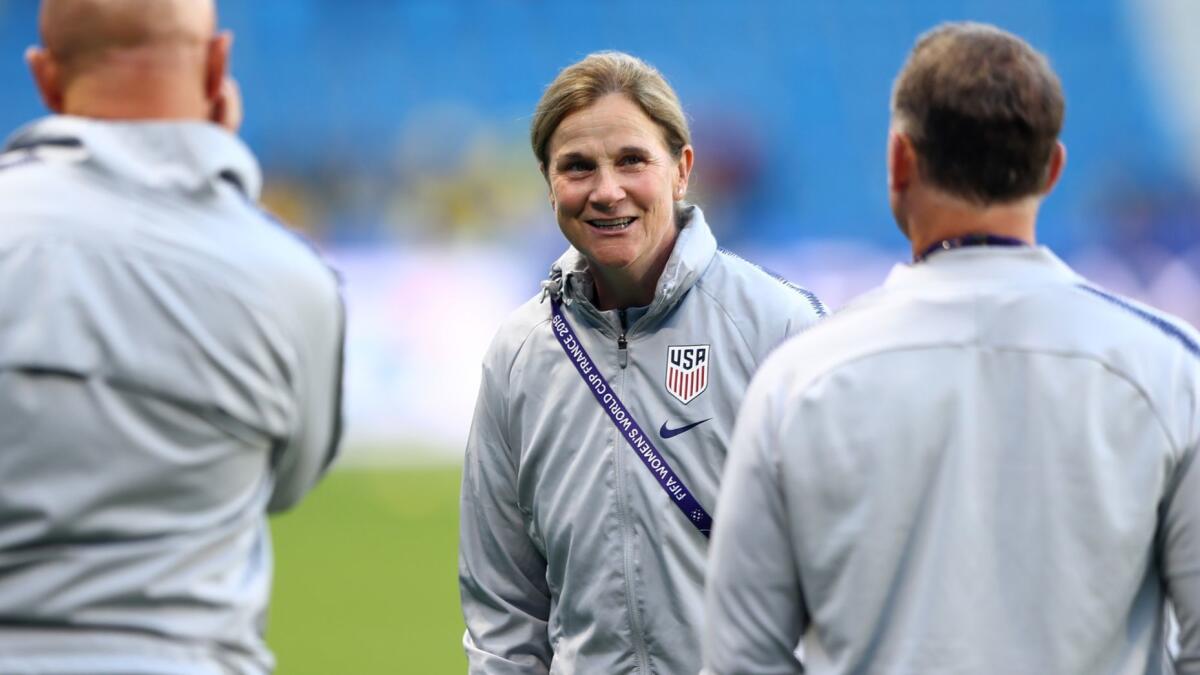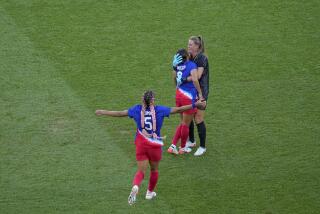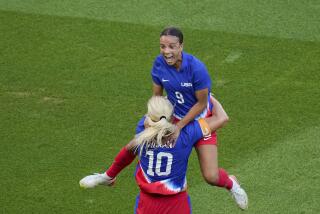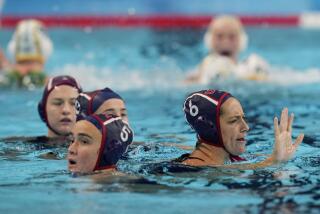Women’s World Cup: Americans made sweeping changes to begin journey to finals

Reporting from Lyon, France — The players on the U.S. national team have talked a lot about the journey that has taken them to Sunday’s Women’s World Cup final. What they haven’t talked much about, though, is how and where that journey began.
For that you have to go back three summers, to the weeks following the team’s loss to Sweden in the quarterfinals of the 2016 Olympics when coach Jill Ellis decided the program had to be overhauled.
The players, the formation, the tactics, everything.
“I remember talking to my staff and saying, ‘We’ve got to make sure we’re prepared for this piece of the evolution’,” Ellis said.
A couple of months later, Ellis added a talent identification position to the coaching staff and hired B.J. Snow, the man who succeeded her at UCLA, to fill it. Over the next two years, Ellis and Snow cast a wide net, calling more than 60 players into camp to audition for the World Cup team.
Before the team could start its climb, it had to hit rock bottom. That came early in 2017 in a 3-0 loss to France, the most one-sided defeat for the Americans in nearly 10 years.
“I remember thinking after that loss that we had a long way to go,” said defender Kelley O’Hara, sitting in a sunny courtyard of the team’s hilltop hotel, a converted 19th century convent with an altar in the lobby and two confessionals, repurposed as planters, flanking the front door.
“But that’s kind of a good thing. You don’t ever want to feel like it’s easy all the time, and things just work out, and there’s no obstacles, and there’s no room for growth or need for growth. Jill, that’s been her biggest thing: wanting to challenge this team and make this team evolve and grow, ever since 2016.”
Just about everything the team had done up to that time was questioned. Players were moved from the positions they had always played to the ones they were best suited for. Crystal Dunn, a former NWSL scoring champion, became a defender as did O’Hara, who had played in two World Cups as a midfielder. Julie Ertz, a defender, moved into the midfield, and Carli Lloyd, a two-time world player of the year as a midfielder, became a forward.
Eleven of the players who made this World Cup roster weren’t on the team four years ago in Canada.
Those new positions didn’t fit the old formation, so Ellis changed that too, going from the staid 4-4-2 she had always used, with four defenders, four midfielders and two forwards, to a fluid, pressing, attack-minded 4-3-3.
“As hard as that was — it was hectic and stressful and difficult and full of obstacles and a lot of uncertainty for a lot of people — it was necessary,” O’Hara said.
Those changes on the field forced other ones to be made off the field. Lloyd moved into a reserve role, Alex Morgan emerged as the captain and leader. New players such as Rose Lavelle, Mallory Pugh and Tierna Davidson had to be taught what it means to be a national team player, following in the massive footsteps of Mia Hamm, Julie Foudy, Kristine Lilly and Abby Wambach.
“That was an evolution as well,” said O’Hara, 30, one of a dozen players on the tournament’s oldest team who has celebrated a 30th birthday. “It’s always been about what is this team at its core. And that’s been a team that has that grittiness, that bite and that never-say-die attitude.
“It’s something that the older players instilled in me when I got on this team and for me it was something that was very important — and is still very important — to make sure this team always embodies.”
As extensive as that evolution has been, it’s been equally successful. Since that loss to France, the U.S. has lost just twice in 49 matches, outscoring the opposition 157-32.
Sign up for our weekly soccer newsletter »
Now the journey that Ellis and her team began after their Olympic disaster, the Americans’ earliest exit from a major tournament, is resulting in more history, this time of the positive kind.
The U.S. is the first country to reach three consecutive Women’s World Cup finals and with a victory over the Netherlands on Sunday, it would become the second to win consecutive titles and the only one to win the championship four times — in eight tries — overall.
Just by showing up for the final, O’Hara and six teammates — Morgan, Lloyd, Ali Krieger, Becky Sauerbrunn, Tobin Heath and Megan Rapinoe — will become the first women to suit up for three consecutive Women’s World Cup finals.
“That is kind of crazy,” she said. “It’s cool. It’s like a baseball stat.”
It also means all seven were on the last U.S. team to lose a game in a Women’s World Cup, eight years ago in the group stage against Sweden. The Americans are 14-0-2 in the tournament since then, losing the 2011 final to Japan on penalty kicks following a game that officially goes into the books as a draw.
“This was what she was building toward,” O’Hara said of the path Ellis plotted to Sunday’s final. “It’s not to say that it was easy and there wasn’t doubts within the team or the players at times. And probably within the coaching staff. But that’s a good thing. You want to make sure you’re not feeling complacent or too confident all the time.
“It’s good to have doubt and to feel like this because that’s where the most growth comes from.”
kevin.baxter@latimes.com | Twitter: @kbaxter11







